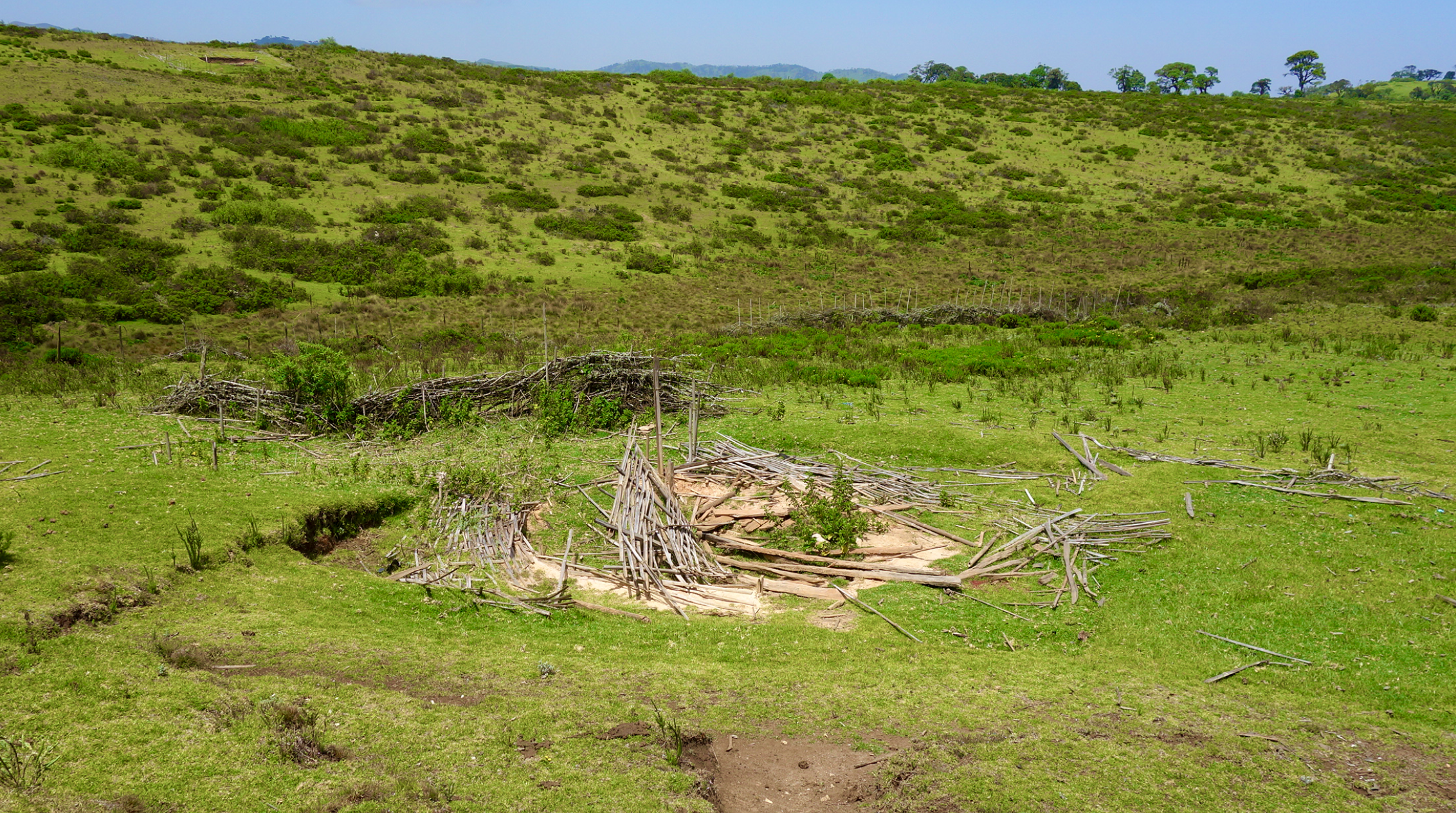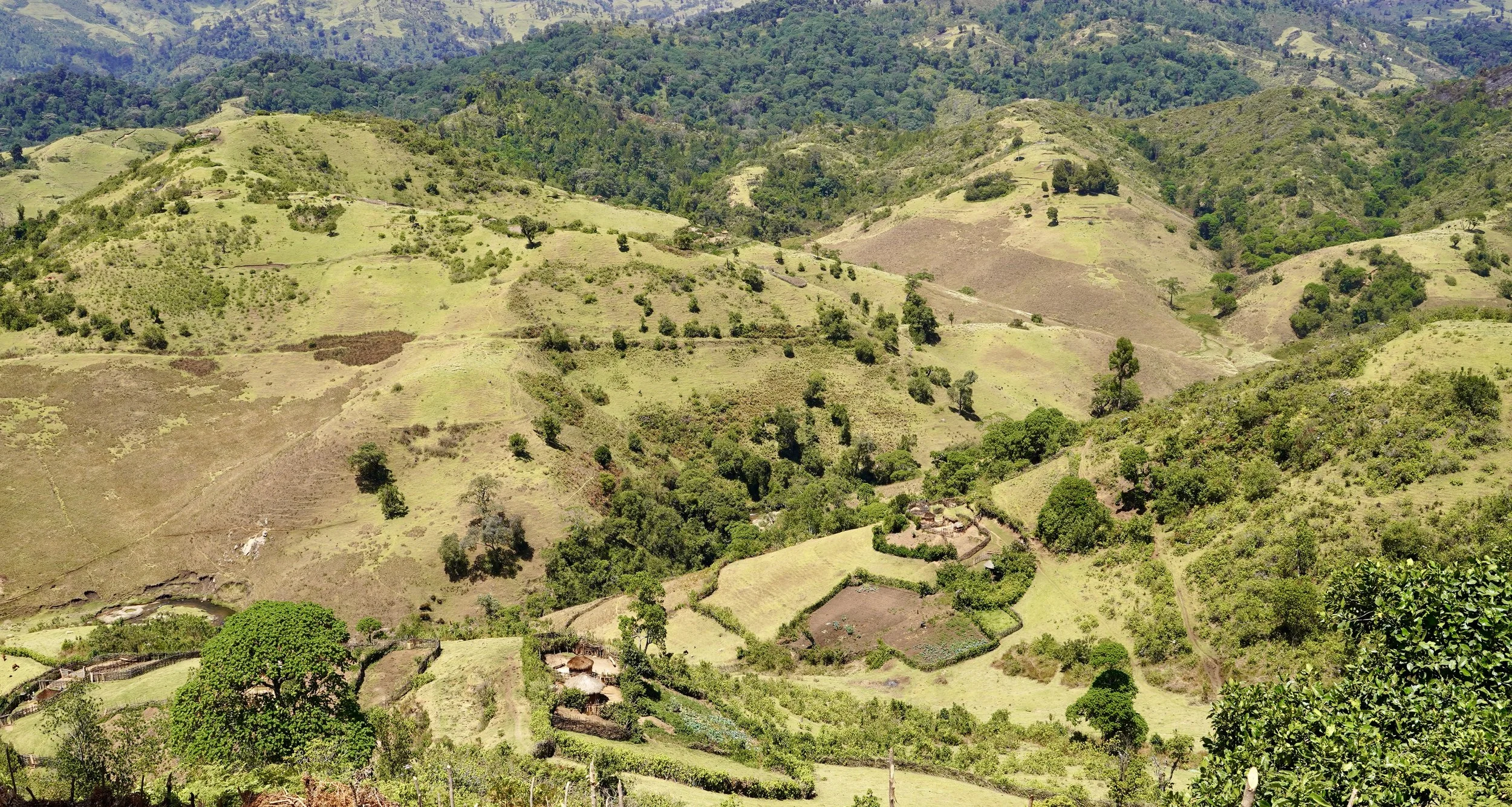The Unruly Ecologies of Embobut:
Everyday Resistance and Emergent Landscapes in Kenya’s Conservation Forests
Samuel Lunn-Rockliffe, Leverhulme Early Career Research Fellow, McDonald Institute for Archaeological Research, University of Cambridge
David K. Kay, Geoarchaeology Project Officer, Oxford Archaeology; Honorary Research Fellow, British Institute in Eastern Africa
Across northwestern Kenya’s Embobut Forest, a mosaic of open grassland, fragmented woodland and burnt vegetation unsettles official Kenyan Forest Service claims that the region is devoid of human activity. Pathways entrained by the daily routines of livestock-rearing, small-scale horticulture and beekeeping run through the landscape, linking temporary shelters, forest gardens and cattle pens amidst the collapsed house foundations and field systems that stand witness to lives uprooted by government-enforced evictions.
These landscapes constitute Embobut’s unruly ecologies, which continue to disrupt state-led attempts to impose fixed, orderly frameworks of environmental management in the name of fortress-style conservation (Brockington 2002). Drawing on ten years of ethnographic and archaeological research in the region, this essay paints a picture of a forested landscape fraught with tensions and contradictions, yet rich in narratives of adaptive creativity and resilience. We examine how everyday practices of displaced forest dwellers continue to reshape Embobut’s contested landscape – one otherwise conditioned by exclusive conservation initiatives and an international political economy inclined towards reductive visions of ethnic succession. Acknowledging this, we need to consider how Embobut’s unruliness can be negotiated rather than eradicated to sustain dynamic and healthy socioecological interdependencies.
Unsettled Histories
Located in the northwestern highlands of Kenya, the Embobut Forest is one of twelve forest blocks blanketing the Cherangani Hills. The forest was historically inhabited by Marakwet and Sengwer communities, both part of the wider Kalenjin ethnic grouping, who migrated into the region c. 250-300 years ago (Lunn-Rockliffe and Kay 2020). Settlement patterns centred on open glades supported livelihoods oriented around the dynamic interplay of foraging, beekeeping and livestock rearing, supplemented by trade with cultivators living on the forest’s peripheries (Kay 2023). Despite long histories of human-forest interaction, in the 20th century, the British colonial Forest Department largely disregarded these relationships, framing local populations as a threat to forest ecologies. This perspective emerged from a broader conservation philosophy that promoted widespread land alienation in the name of environmental protection (Brockington 2002; Neumann 1998; Leach and Mearns 1996).
After its formal gazettement by the British Forest Department in 1954, colonial anxieties of ecological degradation became increasingly validated, as state-led efforts to develop rural economies through the adoption of new agricultural technologies led to their inadvertent adaption in forest areas despite formal conservation prohibitions (Lunn-Rockliffe 2019). Here, forest dwellers started experimenting with new cultivars on their own terms, expanding historic glades by clearing woodland and establishing new homesteads on higher slopes. This marked a gradual diversification of an economy previously oriented around livestock rearing, foraging and honey production, towards one revolving around cultivation. Such transformations were further entwined with the institution of a local road network by Catholic missionaries and the subsequent establishment of markets, schools, health dispensaries, and churches (Kay 2023). Though welcomed locally, these changes fuelled mounting concern amongst conservation authorities, such that repeated and often violent attempts to remove people from the forest interior had become commonplace by the 1980s. Harrowing narratives of such displacement came into international focus in 2010 when community activists complained they had suffered harm under a World Bank-funded natural resource management project (Lynch 2016; Amnesty International 2018). In 2013, a controversial compensation scheme sought to permanently resettle the Embobut Forest’s remaining residents to its peripheries (Daily Nation 2013).
Images of former livelihoods from the Embobut Forest block after the 2013 evictions. Photo by authors.
Yet, as described below, this enforced ‘emptiness’ has remained partial at best. Instead, the forest’s interior still brims with the activity of its former inhabitants, where the ebb and flow of temporary shelters, livestock pens, and horticultural gardens have become interlaced with emergent shrubland and secondary woodland in ways that challenge the stable endpoints favoured by state-led environmental governance and international donor frameworks such as those advanced by the World Bank (KFS 2015).
The Unruly Political Ecology of Forest Governance and Belonging
When we speak of Embobut’s ‘unruliness’, we invoke a political ecology steeped in controversy and contradiction. Here, official governance structures and community efforts for equitable forest management are destabilised by competing political interests, corruption, and wider processes of socioecological change that stifle solution-building processes. For example, Kenya’s Forest Conservation and Management Act (2016) theoretically promotes the creation of Participatory Forest Management Plans through collaboration between the Kenya Forest Service (KFS) and Community Forest Associations (CFAs). However, these processes have been criticised elsewhere for perpetuating a lack of genuine decision-making power for community members, with the KFS retaining control over the plans’ design and related forest revenue (Mutune et al. 2017). Power imbalances have also been reported within CFAs themselves, with board members being accused of manipulating management plans for personal gain from forest plantations (Fuch 2019). So far, no meaningful Participatory Plan has materialised in Embobut, leaving the forest a site of ongoing contestation rather than one of co-management.
At stake within these complex governance structures are more fundamental questions as to who belongs to the forest and whose vision of the future prevails. Competing understandings and imaginings of the past – —including by academics and NGOs – —risk distilling historically fluid and flexible ‘ethnic mosaics’ into essentialised ideas of indigenous and traditional environmental stewardship (Lane 2017). Sengwer activists, for example, have championed community rights to forest access and habitation by mobilising certain forms of knowledge and practice that exclude other, explicitly non-Sengwer communities. These identity claims are created in dialogue with international legislation (e.g. the UN Declaration of Rights for Indigenous Peoples) that privileges particular imaginaries of indigenous environmental stewardship. Such frameworks are then strategically mobilised to challenge the government around ongoing processes of marginalisation.
While these efforts rightly foreground oppressive land management practices and historical injustices, issues arise when rigid identity categories become unmoored from the region’s long-standing histories of migration, intermarriage and economic specialisation, in which ethnic identities have always been contingent on practice, context and circumstance (Lynch 2016; Moore 2011). As a result, previously fluid affiliations become reinvented as fixed ethnic groupings centred on the delineation of who enjoys ‘true’ forest ancestry and the concomitant knowledge of ‘proper’ environmental management, and who does not, often in ways that speak to the expectations of external audiences including human rights groups and advocacy NGOs (e.g. Amnesty International 2018). Consequently, contentions have burgeoned not only between the state and local communities, but also within communities themselves as the forest is drawn into an international political ecology that privileges narrow visions of indigeneity and ethnic succession (see Lynch 2016 for further details).
Everyday Resistance and Emergent Ecologies
Amid the turbulence of these unruly political ecologies, both conservation measures aiming to maintain a ‘pristine’ forest and activist calls for the mobilisation of forms of traditional stewardship are often informed by relatively fixed visions of the past. For conservationists, this typically involves imagining the restoration of a pre-human, undisturbed forest wilderness, while activists often invoke histories of ethnic belonging and selective customary land management practices. These framings, which come to dominate much of the public and policy discourse, tend to obscure the more complex and adaptive practices of Embobut’s evictees, whose everyday actions continue to reshape the landscape in new ways.
Indeed, Embobut today is continually managed through the situated practices and adaptive strategies of its former inhabitants who periodically return to the forest in pursuit of livelihood security. For instance, grassland areas created by past habitation are now expanded for considerable livestock herds, with forest-based animal pens integrated into regional value chains by supplying manure to surrounding farmland. On their former homesteads, displaced residents cultivate biodiverse horticultural gardens intercropped with indigenous and exotic tree species, supplementing livelihood strategies that reach beyond the forest’s edge. Mature woodland copses are also maintained, protected by the enduring, albeit declining, practice of traditional beekeeping that draws on rich ecological knowledge (Lunn-Rockliffe and Cheptorus 2022).
Embobut’s contemporary mosaic ecologies in 2020 depicting forest gardens, open grassland, and mature woodland. Photo by authors.
These adaptive strategies challenge any notion that the Embobut Forest can be ‘restored’ to a fixed baseline, with simple policy solutions often failing to capture how local people’s creative responses lead to unexpected outcomes. It was hoped, for example, that the 2013 eviction package for Embobut’s inhabitants would foster significant arboreous regrowth. However, with many evictees resettling increasingly overcrowded fringes of the forest, the now-empty glades provided ample space for grazing and growing their livestock herds. Community elders could also no longer effectively enforce traditional bylaws that historically kept such activity in check, ultimately resulting in the ongoing expansion of within-forest grasslands. In an attempt to stifle such activities, the KFS occasionally carries out impromptu raids to burn shelters and dismantle stock enclosures. Yet, despite these disruptions, structures swiftly reappear, their reconstruction ironically demanding the harvesting of fresh forest timber that the KFS seeks to protect. In this way, the forest remains animated by an ongoing rhythm of resistance and renewal, a persistent ebb and flow between community action and authoritative reaction. The original goal of forest regeneration remains unmet, with heavy-handed conservation measures instead contributing to the continued reconfiguration of Embobut’s unruly ecologies.
Conclusions: Open-ended futures
If the Embobut Forest is indeed comprised of unruly ecologies that defy simple conservation solutions and activist ideals, how might we envisage its future? We maintain that its unruliness is instructive. By attuning to Embobut’s quiet resistance, we glimpse not only the vulnerabilities of conservation paradigms but also the creative capacities of people who negotiate these terrains on a daily basis. The forest’s unfolding landscape of shifting mosaics reveals an alternative ecological imagination, one that is open to experimentation, negotiation, and flexibility over static endpoints. Rather than seeking a definitive model of the forest, a more promising avenue might be to recognise its emergent properties and the ongoing capacity of local communities to adapt, improvise, and innovate in the face of continuing socioecological change. Embobut’s futures will no doubt remain unruly, resisting singular visions imposed by the KFS or performed by activists navigating the prescriptive expectations of international frameworks and their external backers. Thus, rather than striving to achieve an imagined ideal of a uniform canopy of mature trees stretching into the distance, the challenge lies in guiding this unruliness towards a more equitable, resilient, and healthy socioecological interdependence beneficial for people and trees alike.



